Now that the heat is revving up, you need to be more diligent than ever about the frequency with which you clean your hummingbird feeders. The summer sun can turn the sugar water in your hummingbird feeders sour into a cesspool of bacteria in a few days; even quicker if the feeder is exposed to full sun all day long. Mold and bacteria can grow rapidly in your feeders during times of extreme heat. This leaves hummingbirds susceptible to ingesting them and contracting pathogenic diseases, which can harm them or even result in death.
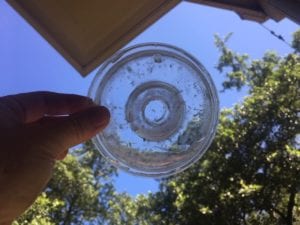
See the mold that’s developed on the base of the feeder? Who would want to drink from this petri dish?
Feeding hummingbirds is a commitment. This commitment entails taking the time to clean your hummingbird feeders following these recommended guidelines: every 3 days (cool weather), 2 days (warm weather), and daily (hot weather). Better to let it run dry for a day than to have to dump out spoiled contents. The hummers will let you know you if you’ve run dry! If you can’t commit to the task, the hummingbirds will be better off finding their own nectar sources. Our blog today offers tips for feeding, attracting, and caring for hummingbirds. See our amazing idea for a perfect cleaning tool below!
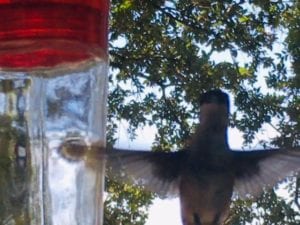
Hummingbirds have a way of letting you know when you need to fill the feeder! “Hello? Is anyone in there?”
4 Best Practices With Hummingbird Feeders:
Hang your hummingbird feeder in an area that has afternoon shade. This helps prevent your sugar water from spoiling as quickly as feeders hung in direct sunlight.
1. Fresh is best. Regardless of where you place your hummingbird feeder, you should be checking it daily to look for signs of mold or bacteria. Fresh nectar attracts more hummingbirds. Only fill the feeder with enough nectar for a couple of days, then rinse/wash feeders and refill.
2. Remember to only use sugar and water in your feeders. Red dye is unnecessary and can actually be harmful to your hummingbirds. Instead, choose a feeder that has red incorporated in its design.
Sugar water: 1 part sugar to 4 parts water. Bring water to a boil and add sugar, stirring until sugar dissolves. Let cool, fill feeders and store extra sugar water in a container in the fridge for up to 2 weeks.
3. Only buy feeders that you can take completely take apart. You’ll need to be able to access all inner nooks and crannies to be able to clean them thoroughly. See our cleaning tips after the “Hummingbird Attracting Plants” list below.
4. Hang your feeder around other plants that attract hummingbirds. This increases the likelihood and speed that the hummingbirds will find your feeder and visit often.
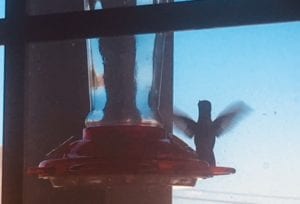
Hummingbirds will come back to you each year if you provide for them. I’m going on the same three visiting for 3 years in a row!

Sugar and water is all you need to attract hummingbirds to your feeders.
Hummingbird attracting plants:
- Agastache
- Agave
- Bee Balm
- Bleeding Heart
- Bluebonnet
- Bottlebrush
- Butterfly Bush
- Butterfly Weed
- Canna
- Carolina Jessamine
- Cape Honeysuckle
- Coral Bells
- Cross Vine
- Cigar Plant
- Columbine
- Desert Willow
- Firespike
- Flame Acanthus
- Flowering Quince
- Gayfeather
- Geranium
- Hibiscus
- Hollyhocks
- Honeysuckle
- Hummingbird Bush
- Hyacinth Bean
- Iris
- Lantana
- Lily of the Nile
- Mist Flower
- Mountain Laurel
- Mexican Bush
- Sage
- Ocotillo
- Penstemon
- Phlox
- Pineapple Sage
- Purple Cone Flower
- Petunia
- Red Hot Poker
- Salvia greggii
- Showy Primrose
- Standing Cypress
- Star Jasmine
- Snapdragon
- Texas Paintbrush
- Texas Sage
- Trumpet Vine
- Turk’s Cap
- Vitex
- Yucca
- Zinnia
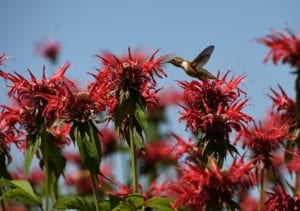
Planting Bee Balm or other nectar plants by your hummingbird feeders will draw them in fast!
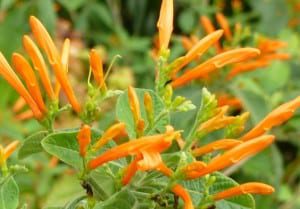
Mexican Honeysuckle is another favorite to attract hummingbirds.

Well, it’s called a Hummingbird Bush for a reason…need we say more?

Turk’s Cap is a great plant to attract many a hummingbird, and it likes shady areas too!
Cleaning Your Hummingbird Feeder
- Soap is not advised, as it can leave residue behind. A hot water rinse, with a little scrubbing if necessary, should be sufficient for most cleanings, if you are keeping up with the maintenance schedule mentioned above .
- If your hummingbird feeder develops mold, remove it from its hanger, discard any remaining sugar water in the feeder, and soak the feeder in a solution of 10% bleach and 90% water, scrubbing small areas inside and outside of the feeder.
- Have designated tools that you only use for your hummingbird feeder: bottle brushes and/or bottle sponges, toothbrushes and floss picks work amazing for the hard-to-reach- spaces and the tiny crevices and holes. See my favorite in pic to right.
That’s all there is to it. You just need to make sure you do it!
~The Happy Gardener

Use uncontaminated tools.
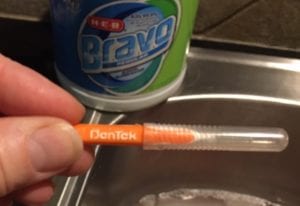
Find this “Den Tek” toothflosser in the toothpaste aisle. It works wonders in the tiniest crevices where mold can hide!

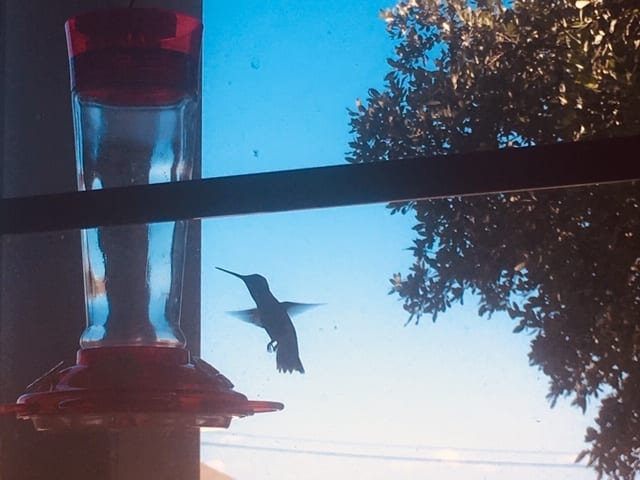
One feeder is in shade and the other in sun so I’d like to move the one in sun but don’t want to confuse Hummers when they come to drink. What should I do?
Hi Nicole,
Hummingbirds do remember where their reliable feeding sources are, so is it possible to slowly move the feeder that is in the sun? Moving it in increments, could keep them coming to the same are, but gradually making their way to the shady spot you prefer it to be in.
I Did Put It In The Shade And then The Sun Got To It, The Hummingbird Feeder. Should I Put A Umbrella Over It ?
It’s always best to have your feeder in a shadier area as sugar water can spoil quickly in extreme temperatures. But if not able to provide shade, as long as you are diligently cleaning it every few days and replenishing sugar water it will be ok. You’ll just have to keep up with the maintenance of cleaning it.
My hummingbird feeder that is in the shade keeps souring. I have one in the sun is doing fine. I’m confused.
Have you checked it thoroughly and removed all parts to look for mildew/mold? sometimes when there is just a little of that lingering, it can cause the batch to quickly turn on you. How often is the sugar water changed out?
I live in the desert, temps reach up to 115. Should I only leave feeders out at dawn and dusk and bring the feeders inside during hottest times of the day?
Wow Linda! That’s hot! The general advise is to not leave a hummingbird feeder out for more than a day when temperatures soar over 93°F. It’s a lot of work, but if you can juggle the times of day you put out your feeders, it’s better than leaving them out all day in the extreme heat. Try to hang them in some shade as well, and you’ll still need to replace sugar water often as mold grows quickly in hot temperatures.
Hello Everyone And Hope Yall Having A Good Day.
Hello. I’m worried as I just found fungus inside the Hummingbird feed, I know that the birds have been exposed to mold / fungus in their feed!
Is there a solution to add to the feed so that if they’ve been infected I can help them? Im devastated
Hi Angie,
I don’t know of a product to add to the solution. I would focus more on just having a consistent cleaning regimen. Food in feeders need to be changed out and washed more often when temperatures are higher, so with cooler fall weather on its way, you may have more peace of mind. Just check often. It isn’t advisable to add anything extra to the feeders except the pure sugar water solution.